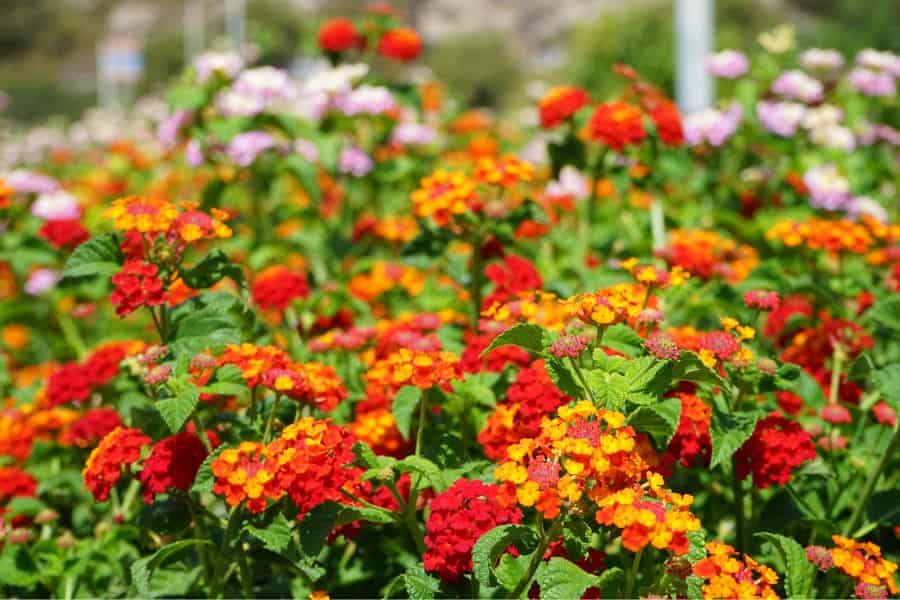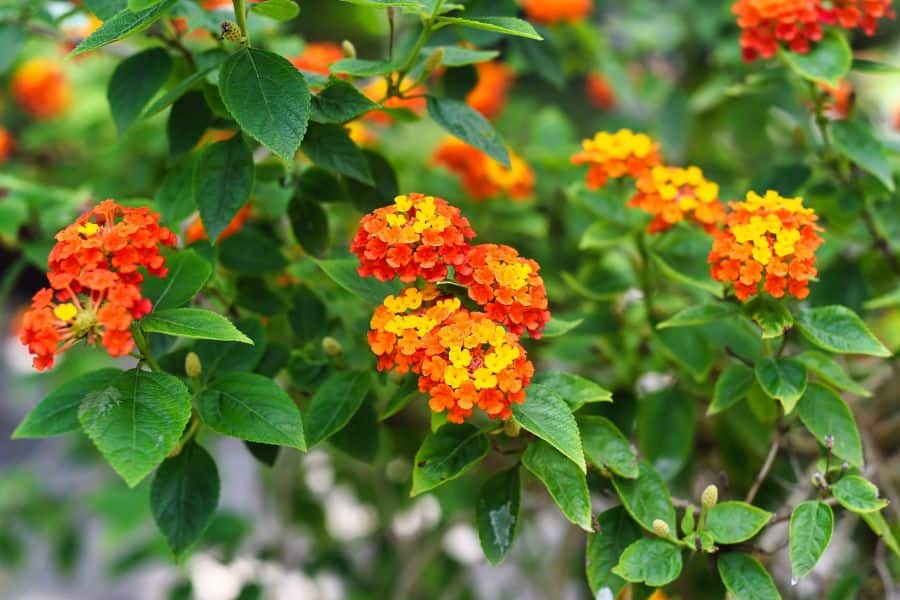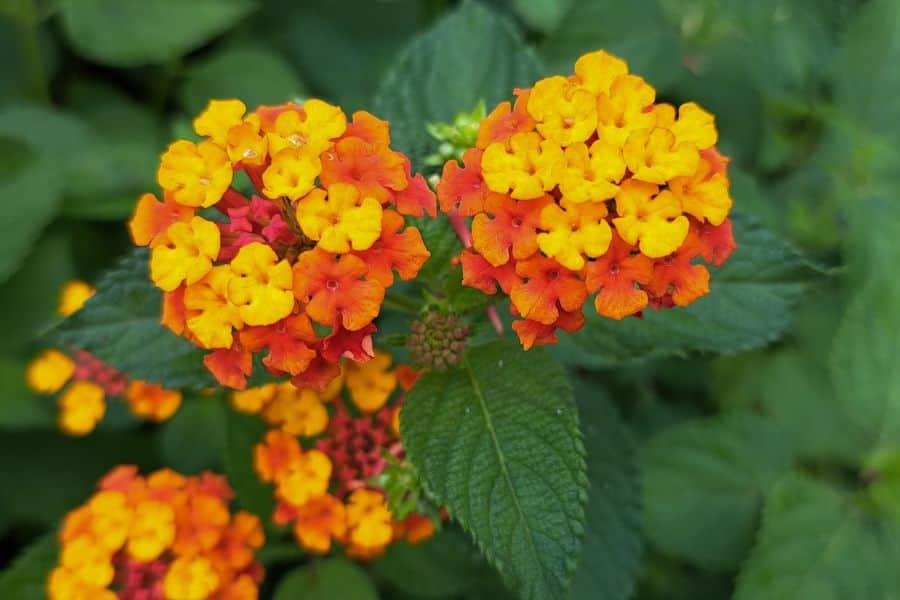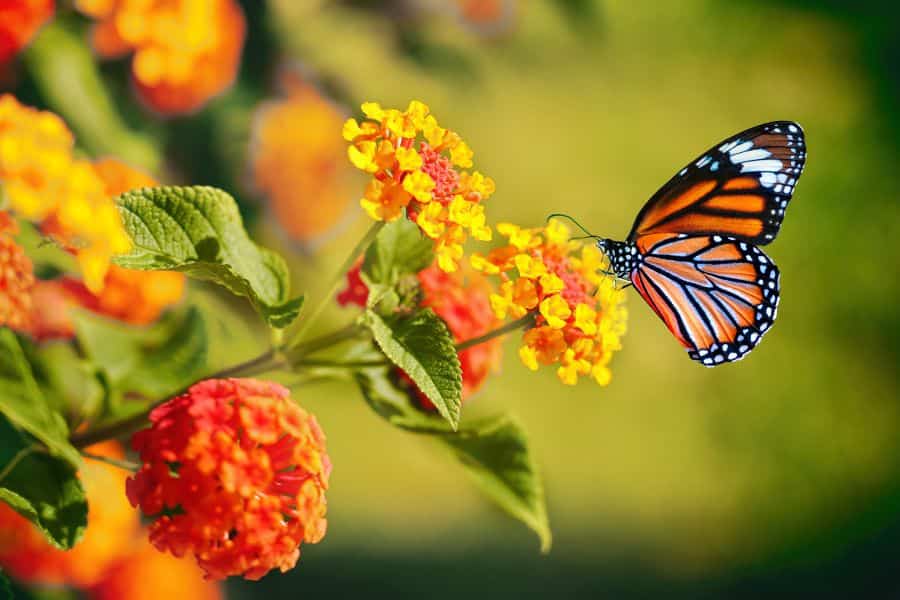Native to tropical regions of the Americas, Lantana is a flowering plant in the Verbenaceae family that is a must-have for many of our customers. Lantana is an extremely hardy Annual (excluding Perennial Miss Huff) that blooms all season long in a multitude of bright colors, from white to yellow to orange to pink to red and even purple and many colors in between. While we won’t always have the same varieties every week, we can always promise a full table of colorful Lantana in Spring & Summer.

Our Selection of Lantana
At Martin Garden Center, we grow Lantana in 4″ containers and buy a whole lot more from our vendors. Beginning in early April and lasting through mid-May, we fully stocky two tables of Lantana, meaning 300+ plants at any given time. After Mother’s Day, we do begin to taper but we generally have Lantana available through the end of summer. We will not always have all varieties, but we try to have a great representation of color. We try very hard to always have Ms. Huff available, as well as Trailing White and Trailing Purple or Trailing Lavender. We have also, from time to time, been able to purchase Lantana Standards from vendors out of Florida.
However, we cannot guarantee that we will always have these from year to year. We are growing the following varieties in 2025:
- Bandana Cherry
- Bandana Gold
- Bandana Lemon Zest
- Bandana Peach
- Bandana Pink
- Bandana Red
- Bandana Rose
- Bandana Sunrise
- Bandana White
- Bandana Yellow
- Bandolero Cherry Sunrise
- Bloomify Red
- Bloomify White
- Chapel Hill
- Confetti
- Dallas Red
- Little Lucky Orange
- Little Lucky White
- Lucky Flame
- Lucky Rose Sunrise
- Luscious Series
- Ms. Huff
- New Gold
- Samantha
- Trailing Lavender
- Trailing White
Growing and Caring for Lantana
Lantana is a relatively low-maintenance plant that is easy to cultivate. It thrives in full sun, although Lantana can tolerate partial shade in the right conditions. However, the plant requires at least 6 to 8 hours of direct sunlight daily to produce abundant blooms. Lantana prefers well-draining soil that is fertile and rich in organic matter. Ensure that the soil has good drainage to prevent waterlogging, which can lead to root rot. The plant is drought-tolerant once established, but regular watering is necessary during its initial growth phase.
Lantana is a relatively low-fertilizer plant, but a balanced slow-release fertilizer can be applied during the growing season to promote healthy growth and abundant flowering. Regular pruning is beneficial for Lantana to maintain its shape, encourage bushier growth, and remove any dead or diseased branches.

Size & Shape
Lantana typically grows between 2 to 6 feet in height and spreads outwards to form a bushy and rounded shape. Some dwarf varieties, such as Lantana ‘Chapel Hill Gold,’ stay more compact, reaching a height of around 1 to 2 feet. The growth habit of Lantana is upright and spreading, with numerous branching stems that create a full and lush appearance.
Leaves and Flowers
The leaves are generally ovate or lance-shaped and have a textured surface. They are arranged in pairs along the stems and emit a distinct, pungent scent when crushed. The foliage is typically dark green, although some varieties may have variegated or serrated leaves, adding to their visual appeal even when the plant is not blooming.
The true beauty of Lantana lies in its flowers. The flowers are small and tubular, clustered together in dense umbels. They come in a wide range of vibrant colors, including shades of yellow, orange, red, pink, and purple. In addition, Lantana is unique in its ability to change flower color as the blooms mature. For example, a cluster of flowers may start as yellow and gradually transition to orange and then red as they age. This creates a stunning multicolored effect on a single plant, often called “tricolor” or “multicolor” Lantana.

Uses in the Garden
Lantana is a vibrant and hardy plant that thrives in hot, sunny gardens, making it a perfect choice for borders, flower beds, and pollinator-friendly landscapes. Its clusters of brightly colored blooms attract butterflies, bees, and hummingbirds, adding movement and life to the garden. With its drought tolerance and ability to handle poor soil, Lantana is an excellent low-maintenance option for xeriscaping, coastal gardens, and erosion control on slopes. Lantana also pairs with other heat-loving plants like Salvia, Coneflowers, and Ornamental grasses, creating a dynamic, colorful display.
Lantana’s spreading and trailing varieties make it ideal for hanging baskets, window boxes, and container gardens, where it spills gracefully over the edges. Compact, mounding types work well in garden borders or as ground cover, filling in spaces with continuous blooms from spring to frost. Because it thrives with little care, Lantana is a great choice for busy gardeners looking for reliable, long-lasting color. Whether used as a bedding plant, a pollinator magnet, or a cascading feature in containers, Lantana brings bold beauty and resilience to any landscape.

Frequently Asked Questions
Is Lantana Poisonous?
Yes, Lantana plants can be toxic if ingested. Lantana contains compounds, such as triterpenoids and pentacyclic alkaloids, that can harm humans and animals if consumed. Ingesting parts of the plant, especially the berries, can lead to symptoms such as nausea, vomiting, abdominal pain, and other digestive issues. In some cases, more severe reactions may occur.
Can Lantana Survive the Winter?
In the Upstate’s Zone 8A climate, we generally treat Lantana camara as an annual — it will give you bright color all summer long, but without special protection it usually won’t reliably survive the winter. However, one standout variety — Miss Huff — is regarded as a true die-back perennial in this region, meaning its top growth may die down but the root system can reliably spring back each year. Some of the more tolerant lantana cultivars may survive mild winters in Zone 8A if well mulched and sheltered, but they are not dependable year-after-year without extra care. For more detailed instructions on Winterizing Lantana — check out this Lantana Winter Guide.
Do Deer Eat Lantana?
Lantana is generally considered deer-resistant, meaning that deer tend to avoid feeding on it. The pungent aroma and bitter taste of lantana foliage make it less appealing to deer, and as a result, these plants are often left untouched in areas with deer populations. While no plant can be considered completely deer-proof, lantana is a good choice for gardens in regions where deer are prevalent, as it is less likely to attract their attention.
Does Lantana Attract Bees?
Yes, lantana plants are known for attracting bees, butterflies, and other pollinators. The small, brightly colored lantana flowers produce abundant nectar, which is highly attractive to bees. Bees are essential pollinators for many plants, including lantana, as they help facilitate the transfer of pollen between flowers, which is necessary for the plants to produce seeds and reproduce. So, planting lantana can be a great choice if you’re looking to attract bees to your garden.
